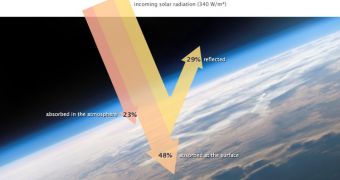According to a new scientific investigation, it would appear that analyzing how ordinary drinking glass shatters may hold clues to how climate change will evolve here on Earth. The new investigation was led by experts at the National Center for Atmospheric Research (NCAR).
What the team found was that microscopic particles of dust can break apart in patterns that are very similar to those created by breaking glass, and other brittle objects as they are destroyed.
Details of the research were published in the latest issue of the esteemed journal Proceedings of the National Academy of Sciences (PNAS).
According to NCAR scientist Jasper Kok, the leader of the research effort, there might be several times more dust particles in Earth's atmosphere than previously thought, a fact that would carry significant implications for the evolution of global warming and climate change.
This conclusion is based upon another discovery in the new study, showing that shattered dust appears to produce an unexpectedly high number of large fragments. If that is true, then the amount of sunlight passing through the atmosphere needs to be recalculated.
Another complex issue here is represented by the traits of individual dust particles. Whereas some cool Earth by reflecting sunlight, others heat it up by trapping heat in the atmosphere.
“As small as they are, conglomerates of dust particles in soils behave the same way on impact as a glass dropped on a kitchen floor,” Kok explains.
“Knowing this pattern can help us put together a clearer picture of what our future climate will look like,” the team leader goes on to say. He adds that this research might help boost weather forecasting accuracy .
This is especially true for areas that contain large amounts of dust. In addition to temperatures, dust particles also regulate precipitation patterns and cloud formation.
“This research provides valuable new information on the nature and distribution of dust aerosols in the atmosphere. The results may lead to improvements in our ability to model and predict both weather and climate,” says expert Sarah Ruth.
She is the program director of the Division of Atmospheric and Geospace Sciences (DAGS) at the US National Science Foundation (NSF). The organization provided the funds for the new NCAR research.
The investigation was based on past studies conducted by physicists, who showed that brittle objects, such as glass, rocks, or even atomic nuclei, can break apart in predictable patterns.
“The idea that all these objects shatter in the same way is a beautiful thing, actually. It's nature's way of creating order in chaos,” Kok concludes.

 14 DAY TRIAL //
14 DAY TRIAL //